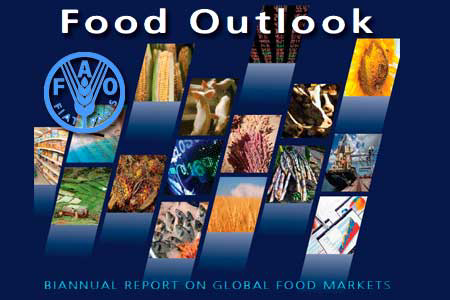FAO report predicts more balanced 2013/14 cereal market

Food commodity markets, in particular for cereals, are set to be more balanced in 2013/14, according to the FAO’s recently released Food Outlook report.
World food imports in 2013 are tentatively forecast at $1.09 trillion, close to last year’s level, but 13% below the record of 2011, the biannual report on global food markets said. Higher bills for fish and livestock products are anticipated to offset lower expenditures on most other commodities, especially sugar.
Prospects for abundant domestic crops in the least developed countries (LDCs), low-income food-deficit countries (LIFDCs) and countries in sub-Saharan Africa are expected to limit their import needs.
With the world cereal harvest forecast to surge to a record 2,460 million tonnes in 2013, cereal prices could ease, with markets becoming calmer, Food Outlook said.
Latest indications point to a more comfortable world cereal supply-and-demand balance in the new 2013/14 marketing season. After a relatively tight situation and high prices in 2012/13, “good production prospects and a likely replenishment in world stocks could pave the way for calmer markets and some easing of prices in the new season,” the report said.
This year’s forecast record cereal production would represent a 6.5% increase on last year’s reduced level, supported by higher global wheat output and a sharp expected rebound of maize production in the United States. Rice production is also set to increase in 2013, although concerns over diminishing prices may dampen growth.
Utilisation growth
Global cereal utilisation is forecast to reach 2,402 million tonnes in 2013/14, which is 3% above 2012/13. Much of the growth would stem from higher use of maize for feed and industrial purposes in the United States.
Total feed use of coarse grains is forecast to be greater in developing than in developed countries for the second consecutive season.
Based on current prospects, by the end of seasons in 2014, world cereal stocks could register an 11% recovery to 569 million tonnes, the highest level in 12 years.
World trade in cereals is forecast to reach 306 million tonnes in 2013/14, similar to the 2012/13 level. A reduction in wheat trade is expected to offset a rebound in maize while rice trade in 2014 is forecast to change little.
Forecasts for other commodities included:
Meat – World meat production is forecast at 308.2 million tonnes in 2013, a modest increase of 4.3 million tonnes, or 1.4% on 2012. While producers in many countries continue to face high feed prices, these started falling in 2012, and could further diminish in 2013.
Milk and milk products – International prices of dairy products registered strong growth during the first four months of 2013, particularly in March and April, and high prices are expected for the next few months. The main cause of the price surge was a steep fall-off in New Zealand’s milk production.
Fish and fisheries products – Global production is expected to reach a new record level in 2013, topping 160 million tonnes for the first time. Fish for direct human consumption will also increase significantly during 2013 as a smaller share of captures is destined for fish meal production. On a per capita basis, overall global fish consumption is approaching 20 kg a year, with aquaculture contributing close to half.
Oilseeds – Expectations of a marked rebound in global oilseed output for 2012/13, combined with a slowing consumption growth, have led to a softening in world prices. Positive early production forecasts for 2013/14 suggest a more balanced world supply-and-demand situation, and thus a general easing of prices.
Quinoa as special feature
In a special section on quinoa – with 2013 declared “International Year of Quinoa” by the United Nations – Food Outlook noted that the Andean commodity has vast potential for production and trade expansion.
“World demand is expected to keep growing vigorously in the coming years, driven primarily by developed countries, where expenditure on healthier and natural foods is on an upward trend,” the report said.
There is also potential for introducing quinoa as a new crop in other parts of the world besides the Andes given its resilience and low water requirements, Food Outlook added.











